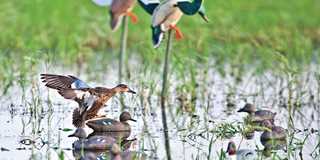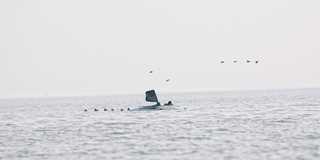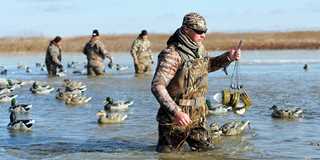Motion Decoy Strategies
The right kind of movement in your decoy spread can make all the difference
The right kind of movement in your decoy spread can make all the difference

By Hampton Bourne

Photo CHRISDOUGLAS.PHOTOGRAPHY
In the late 1990s the spinning-wing decoy crashed onto the duck hunting scene like a tsunami. Two decades later, it has become the most widely used motion decoy, and most hunters have at some point integrated spinners into their decoy spreads. A superstar to some hunters and pariah to others, these decoys have definite strengths and weaknesses.
The first spinning-wing decoy traces its roots to California's Sacramento Valley. The initial prototype was rather basic and consisted of a single spinning blade, powered by a small electric motor, atop a stake. The blade's alternating colors produced a strobe effect. The magic comes from the strobe. Unlike humans, ducks can see in the ultraviolet spectrum, which allows them to pick out a hunter's face shining in the sunlight as well as a spinning-wing decoy from two to three times farther than the human eye can see it. Likewise, a duck's sharp vision and eyes on the side of its head allow it to see a wide panorama of motionor lack thereofin a decoy spread.
While some hunters achieve tremendous results with their motion decoys, others insist that they cause more harm than good. Here are a variety of tips from experts who make motion work.
The spinning-wing concept spread like wildfire. Terry Denmon, an engineer by trade, was approached by a friend who owned a sporting goods store. Their goal was to develop a small, battery-powered motor that could drive spinning wings on a duck decoy. The idea quickly morphed into MOJO Outdoors, which has since established itself as a major manufacturer of spinners and other motion decoys.
Denmon separates his theory of motion into two categories: "long-range strobe" and "simple motion." Long-range strobe, he says, is "the flash of a spinning-wing decoy generated by turning a wing at a certain minimum speed." Simple motion, he continues, is "any movement not within the spinning-wing concept. This could be movement of decoys, water, or wings that do not produce the strobe or flash."
If motion decoys were duck calls, the strobe would be the highball, and simple motion would be the lonesome hen. Like the highball, the strobe is very effective at attracting ducks from long ranges but can cause them to flare when they're in close, particularly later in the season. Simple motion, on the other hand, is not visible to ducks from a distance but is more likely to help finish birds, just like the lonesome hen call.
While MOJO made the spinning-wing decoy famous, Higdon Outdoors pioneered the development of other types of motion decoys. In 1994, Mark Higdon built a goose decoy with a moving head, which went on to become the first mass-produced motion decoy.
Brook Richard, corporate relations manager for Higdon Outdoors, explains Higdon's idea of motion. "Visual motion," he says, "is produced by decoys that can be seen from a distance, but visual motion is not always useful when you're trying to finish ducks. Water motion, on the other hand, is the process of putting a ripple on the water to make decoys move. With visual motion you're trying to attract ducks from a long distance. With water motion you're trying to get circling ducks to commit."
The message is simple. Some motion decoys attract ducks from long distances, while others put ducks at ease when they are circling your spread. Understanding the difference helps you to be more strategic and creative when using motion.

Photo TODDSTEELEPHOTOART.COM
It's no secret that decoy positioning is crucial to successful duck hunting, and that is especially important with the placement of motion decoys. Conventional wisdom indicates that if a decoy looks like a duck landing, it should be positioned in a spread where you want ducks to land. While placing a decoy in the middle of a landing hole may not be a terrible idea, a little more thought and creativity can yield better results.
Mark Kirsten has been hunting the rice fields of his family's Sacramento Valley farm for nearly 30 years, and he has experienced the evolution of spinning-wing decoys firsthand. "When the original spinners were invented, they were almost unfair," Kirsten says. "Their effectiveness has lessened over time, however, and the farther south you go, the less effective they can be." As ducks move down the flyway, he explains, and especially as the season progresses, they can begin to see the strobe produced by the spinning wings as something unnatural.
"In my experience," Kirsten continues, "as the season moves on, ducks don't always finish as well when the spinners are spinning. I use one only if it has a remote, and we always turn it off as ducks get closer. As the season moves on, I also tend to place them farther and farther away from my blind. If ducks begin to act leery of a spinning-wing decoy, I'll even put it outside my spread and partially behind cover so ducks can see it only at certain points in their circle. I think it can be a great tactic to continue attracting ducks without sacrificing the ability to finish them."
Denmon endorses the tactic. "One of the biggest misconceptions for spinning-wing decoys is that they are good finishers," he says. "The decoy was always intended to be a long-range attractor. But if ducks become shy and you remove it completely from your spread, you give up the ability to attract ducks from far off. If they aren't finishing because of your spinning-wing decoy, move it to the far end of your spread, out of your landing hole. If you need to, move it a hundred yards outside your spread. It might not look as natural to us, but at least you're still attracting ducks from far away. Once they are close enough to be shy of the strobe, the spinners have already done their job."

Photo LONG SHOT PHOTOGRAPHY
Ron Kee is a lifelong New Yorker who cut his teeth hunting ducks in the saltwater marshes of Long Island. A Wall Street veteran and former New York state DU vice chairman, he now hangs a shingle as a pro staffer for several waterfowling manufacturers including Mossy Oak, Drake Waterfowl, Buck Gardner Calls, and Tanglefree.
Changing weather conditions can present a challenge for any hunter, but those on our nation's coasts also have to deal with tides. "Sometimes, the tide can shift six to eight feet over the course of a hunting day," Kee says. "In a falling tide, a decoy on a pole will eventually stand too far out of the water. In a rising tide the same decoy will quickly be covered with water. We usually hunt from boats and almost always use floating spinning-wing decoys so our profile and motion adjust automatically with the tide."
Hunters logging hours on coastal waters can also see a higher frequency of strong winds. "Most of the time we hunt sea ducks in a stout wind," Kee continues. "We frequently use wind-powered spinning-wing decoys. While many inland hunters won't see winds with enough power to spin motorless decoys, we commonly hunt in winds that produce the strobe that ducks can see from a long way away. They're also lightweight and very affordable."
Kee also encourages hunters to remember some tried and true old-school motion tactics. "Flagging passing ducks is one of the most effective techniques we use," Kee says. The flag he uses is a black, square flag on a handle, similar to a black golf flag. Hunters grip the handle and flap the flag to simulate a duck or goose flapping its wings. "When ducks are at a distance, I'll hit them with a few flaps," Kee continues. "I just use a few flicks to get their attention, and once they start coming, I'll stop flapping. Unlike dabblers, many divers and sea ducks don't respond well to a duck call, so flagging gives me the same feeling of involvement that calling does. It really is an art form and can be a lot of fun."

Photo JIM THOMPSON
If the waterfowling community crowned a "King of Motion," Ronnie Capps would be a strong contender. A retired game warden and current professional outfitter, Capps is widely regarded as an expert at bringing life to a dull decoy spread, to the point that clients have referred to his Reelfoot Lake timber hole as "Duck Disneyland."
Capps believes that shy ducks require a more delicate approachsomething many decoy spreads lack. "You will scare far more ducks with erratic motion than subtle motion. Many hunters use what I call 'The Haunted House Scenario,'" he says. "If you use too much motion at the wrong time, it's like a guy with a chainsaw popping out at a haunted house.
"Keep your motion decoys on a remote or a hardwire switch, and don't ever hit your heavy motion decoys when the ducks are looking right at your spread. When they get downwind and aren't looking directly at you, hit your motion decoys a few times to stir up the water and create ripples and motion out of the corners of their eyes. I am also a big believer in swimming decoys, especially in and around my landing hole. I believe they are extremely beneficial when used for finishing ducks."
Higdon's Richard agrees. "Ducks move, and they move a lot," he says. "I think the biggest mistake people make is devaluing the power of water motion, especially when there's no wind or if you're in the woods. Water motion is critical for finishing ducks."
"With decoys arranged in a classic half-moon pattern, there are several different ways to use motion best," Richard adds. "First, make sure your motion decoys are slightly upwind in the spread so the ducks will continue flying over them as they circle. Also consider placing a motion decoy among static decoys to compound their effectiveness. Putting a low-key motion decoy, like a swimmer, exactly in the spot where you want the ducks to land is also a great tactic."
Supplementing your decoy spread with motion isn't guaranteed to increase your harvest, but it's hard to argue against it. The key is being strategic. While some decoys are meant to function like a hammer, others play subtler but equally important roles. Success comes when you understand the hunting conditions, read the birds' behavior, and use the right tools for the job.
Ducks Unlimited uses cookies to enhance your browsing experience, optimize site functionality, analyze traffic, and deliver personalized advertising through third parties. By continuing to use this site, you agree to our use of cookies. View Privacy Policy